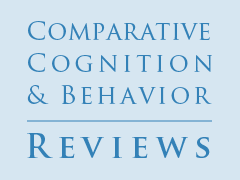Musings on Comparative Directions for Situated Cognition
Reading Options
Abstract
This commentary endorses Cheng’s message that situated cognition should be considered more broadly in the field of comparative cognition and that our understanding of situated cognition would profit from a comparative perspective. Additional phenomena that can be framed in terms of distributed cognition are identified. Hybrid machine–animal intelligence is offered as another possible case of situated cognition. The analogy of the extended phenotype is suggested as relevant to comparing conservative and liberal versions of situated cognition. Examination of the evolutionary history and function of situated cognition is identified as a contribution that comparative analysis can provide.
Keywords: situated cognition, distributed cognition, comparative cognition, hybrid intelligence, extended phenotype
Cheng’s target article provides a good overview of the various ways in which cognition has been considered to extend beyond the boundaries of the brain. As he points out, this idea comes in a variety of forms that have developed in very different research traditions. The conceptual foundation of cognition extending beyond the central nervous system has been extensively explored in philosophy of mind and by those in the cognitive sciences with a more philosophical bent. Many examples of empirical support for this approach have been explored in the domain of human cognition. Cheng provides an excellent review of some cases of nonhuman cognition that can be understood in the framework of situated cognition. He distinguishes “conservative” versions of situated cognition, preserving the essence of cognition in representations and operations on those representations, in contrast to “liberal” versions, which accommodate the extension of cognition beyond the central nervous system by reframing the nature of cognition in one of several ways (see also Wilson, 2002).
I agree with Cheng that exploring situated cognition from a comparative perspective is likely to be productive, both for our understanding of animal cognition and for our understanding of situated cognition. Following Cheng’s lead of offering a “showcase to start a dialog” (p. 2) about the directions that situated cognition might take the field of comparative cognition (and be taken by it), I offer some thoughts on several directions that a comparative approach to situated cognition might lead.
Distributed Cognition: The Scope of Comparative Examples
Cheng suggests eusocial insects as a good starting point for consideration of (socially) distributed cognition. The wide range of complex, highly coordinated, and sophisticated social behavior makes them an excellent place to explore the possibility that cognitive processes are distributed over individual animals in a manner that meaningfully shifts the unit of information storage and processing from the individual animal to the group.
Other cases that appear likely to support distributed cognition include the complex coordination of group movement found in fish schools and bird flocks. Couzin (2009) reviewed collective decision making in this context that suggests processes best understood as situated in the group rather than individual animals. The tendency of many fishes to spatially align with close neighbors, for example, results in “amplification” of the ability of schooling fish to detect and react appropriately (change swimming direction) to a threat more reliably than an individual fish could. The process is similar to feedback systems in neural circuits that amplify signals. On the surface, at least, the models described by Couzin (e.g., from Couzin, Krause, James, Ruxton, & Franks, 2002) meet the Kaplan (2012) mutual manipulability criterion championed by Cheng; information flows between individual-level mechanisms and group-level mechanisms controlling movement. As an aside, it is worth mentioning that cognition distributed among animals moving in groups may be in a fuzzy boundary between Cheng’s species of distributed cognition and enacted cognition.
Even in animals with much less complex social interactions, considering social processes as a form of (or a component of) cognition may have merit. In pairs or small groups of foraging laboratory rats, for example, social interactions are generally considered to be part of the environmental input that is stored and processed in the brains of individual rats (e.g., Brown, 2011). But work focused on the dynamics of group formation and interactions among individual foragers suggests processes that might be best understood in terms of information stored and processed by the group of rats rather than by each individual (Weiss, Segev, & Eilam, 2015). The extent to which reframing social interactions as part of cognitive processes involved in social behavior rather than part of the environmental input to those processes helps us understand those processes is, at this point, an open question. I agree with Cheng it is well worth pursuing.
Distributed Cognition and Hybrid Intelligence
In the wake of advances in artificial intelligence and machine learning, several approaches to integrating artificial intelligence with naturally occurring behavioral and cognitive processes have emerged. Smart (2018) reviewed the state of these approaches from the machine learning perspective. Talwar et al. (2002) provided an early example of a cyborg behavioral control system. Stimulation of sensory areas of the brain associated with whiskers on the left and right side of the rat and in the medial forebrain bundle (a known “reward center”) allowed the movement of rats through a complex environment to be partially controlled. Specifically, the rats could be steered by the relative level of stimulation to the sensory areas corresponding to the left- or right-side whiskers. Recently, Yu et al. (2016) used Talwar et al.’s cyborg system to develop a case of what they termed “cyborg intelligence.” Rats’ movement through a maze was partially controlled to conform to information determined by a maze-solving algorithm, but choices also varied as determined by the rat. Yu et al. compared the performance of the maze-solving algorithm, rats not controlled by the system, and the rat–algorithm cyborgs in an attempt to understand how the machine and rat determinants of choice behavior are integrated.
The specifics of Yu et al.’s (2016) attempt to integrate artificial and rat spatial memory and spatial control have important limitations. But it encourages work combining machine learning with animal cognition and points the way to using the interaction between elements of cyborg cognitive systems that are artificial and those that are natural as a new means to test cognitive theories (Brown & Brown, 2017). Future interdisciplinary work integrating cognitive processes in nervous systems with intelligent machines seems likely to force an understanding not only of how cognitive processes can be situated in machines but also of how such artificial intelligence can be integrated with cognitive processes situated in brains. Such an approach is a special case of situated cognition in which natural and artificial cognitive processes share their traditional platforms of brains and silicon chips and work together in yet-to-be-determined ways.
Conservative versus Liberal Situated Cognition: A Useful Analogy from Evolutionary Biology?
It has been previously noted that the idea of extended or situated cognition is reminiscent of Richard Dawkins’s (1982, 2004) concept of “The Extended Phenotype” (e.g., Schulz, 2013). Dawkins’s idea is that the scope of natural selection extends beyond the bodies and behavior of organisms to include parts of the environment with which the organism interacts. Artifacts created by animals (e.g., beaver dams) are one kind of example. Other organisms with which there is a parasitic or symbiotic relationship are another. The processes central to natural selection—variation, selection, and reproduction—can operate on these parts of the extraorganism environment just as they operate on the body and behavior of the organism. Thus, the scope of genetic influences extends to the social, interspecific, and physical environment of the animal.
Likewise, the forms of situated cognition reviewed by Cheng expand the scope of cognitive processes beyond the central nervous system. In what Cheng terms “conservative versions” of situated cognition (p. 2), the representational basis of cognition is preserved, but the platforms in which information can be stored and on which it can be processed are expanded from the central nervous system to other parts of the body, to other animals, and to parts of the environment with which the animal interacts.
Schulz (2013) rejected the idea that an extended phenotype view provides direct support for extended cognition but considered the value of the former as analogous to the latter. In both cases, the essence of the processes and principles involved (in natural selection and cognition, respectively) is preserved, but the platforms to which they apply are extended. Framing the platforms on which cognitive processes operate as extending beyond the central nervous system (conservative versions of situated cognition) rather than as requiring fundamentally different conceptualizations of cognition itself (liberal versions) is likely a more fruitful approach for comparative cognition, just as considering the effects that genes have beyond the body as part of the phenotype on which natural selection operates has arguably been more fruitful in evolutionary biology than reconceptualizing the processes of natural selection.
Evolutionary History of Situated Cognition
Examining cognition from a comparative perspective not only allows a much wider range of cognitive processes to be studied but also can allow ideas about the evolutionary function and evolutionary history of cognitive processes to be tested (e.g., Shettleworth, 2010). The same arguments for comparative work can be applied to situated cognition, as Cheng makes clear.
Beyond the general point, however, there appears to be a (implicit, as far as I am aware) view that some forms of situated cognition, at least, are recent evolutionary developments. For example, Gallagher (2013; used by Cheng as a primary example of radical situated cognition) pointed to human social and cultural structures as the platform of extended cognition. On the other hand, the wide range of apparent cases of situated cognition in nonhuman animals and its phylogenetic scope suggest that situated cognitive process may be evolutionarily ancient. Which came first, cognition or brains? What are the necessary and sufficient conditions for cognitive processes? Did they evolve once, or was there convergent evolution of cognition—in neural and non-neural platforms—among different groups of organisms? These questions can be addressed only from a comparative perspective.
References
-
Brown, M. F. (2011). Social influences on rat spatial choice. Comparative Cognition and Behavior Reviews, 6, 5–23. doi:10.3819/ccbr.2011.60003
-
Brown, M. F., & Brown, A. A. (2017). The promise of cyborg intelligence. Learning and Behavior, 45, 5–6. doi:10.3758/s13420-016-0249-7
-
Cheng, K. (2018). Cognition beyond representation: Varieties of situated cognition in animals. Comparative Cognition and Behavior Reviews, 13, 1–20. doi:10.3819/CCBR.2018.130001
-
Couzin, I. D. (2009). Collective cognition in animal groups. Trends in Cognitive Science, 13, 36–43. doi:10.1016/j.tics.2008.10.002
-
Couzin, I. D., Krause, J., James, R., Ruxton, G. D., & Franks, N. R. (2002). Collective memory and spatial sorting in animal groups. Journal of Theoretical Biology, 218, 1–11. doi:10.1016/j.tics.2008.10.002
-
Dawkins, R. (1982). The extended phenotype. Oxford, England: W.H. Freeman.
-
Dawkins, R. (2004). Extended phenotype—but not too extended. A reply to Laland, Turner and Jablonka. Biology and Philosophy, 19, 377–396. doi:10.1023/B:BIPH.0000036180.14904.96
-
Gallagher, S. (2013). The socially extended mind. Cognitive Systems Research, 25–26, 4–12. doi:10.1016/j.cogsys.2013.03.008
-
Kaplan, D. M. (2012). How to demarcate the boundaries of cognition. Biology & Philosophy, 27, 545–570. doi:10.1007/s10539-012-9308-4
-
Schulz, A. W. (2013). Overextension: The extended mind and arguments from evolutionary biology. European Journal for Philosophy of Science, 3, 241–255. doi:10.1007/s13194-013-0066-1
-
Shettleworth, S. (2010). Cognition, evolution, and behavior (2nd ed.). New York, NY: Oxford University Press.
-
Smart, P. R. (2018). Human-extended machine cognition. Cognitive Systems Research, 49, 9–23. doi:10.1016/j.cogsys.2017.11.001
-
Talwar, S. K., Xu, S., Hawley, E. S., Weiss, S. A., Moxon, K. A., & Chapin, J. K. (2002). Rat navigation guided by remote control. Nature, 417, 37–38. doi:10.1038/417037a. PMID:11986657
-
Weiss, O., Segev, E., & Eilam, D. (2015). “Shall two walk together except they be agreed?”: Spatial behavior in rat dyads. Animal Cognition, 18, 39–51. doi:10.1007/s10071-014-0775-7
-
Wilson, M. (2002). Six views of embodied cognition. Psychonomic Bulletin & Review, 9, 625–636. doi:10.3758/BF03196322
-
Yu, Y., Pan, G., Gong, Y., Xu, K., Zheng, N., Hua, W., … Wu, Z. (2016). Intelligence-augmented rat cyborgs in maze solving. PLoS ONE, 11, e0147754. doi:10.1371/journal.pone.0147754

